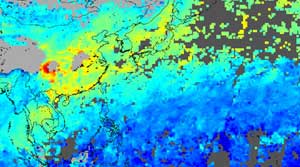How will global warming affect life on Earth? Uncertainties about future climate change and the impact of human activity make it difficult to predict exactly what lies ahead. But the past offers clues, say scientists who are studying a period of warming that occurred about 55 million years ago.
In a joint project of the University of Michigan, the University of New Hampshire and the Smithsonian Institution, researchers have been analyzing fossils from the badlands of Wyoming found in a dist

Answer one of natural history’s most intractable questions
All of Madagascar’s living Carnivora (an order of mammals that includes dogs, cats, bears, hyenas and their relatives) descended from a single species that dispersed from Africa to Madagascar, apparently floating across the ocean barrier aboard wayward vegetation about 24 million to 18 million years ago. Previously, scientists believed that Madagascar’s seven living species of native Carnivora represented two to four
Highlights, including authors and their institutions
The following highlights summarize research papers in Geophysical Research Letters (GL), Journal of Geophysical Research – Solid Earth (JB), Journal of Geophysical Research – Atmospheres (JD), and Journal of Geophysical Research – Planets (JE). The papers related to these Highlights are printed in the next paper issue of the journal following their electronic publication.
1. Another Great Salinity Anomaly?
A largely overlooked but significant factor in marine ecology concerns the effects of variable pH on the growth rate and abundance of coastal marine phytoplankton, the base of the marine food chain in productive coastal waters. The pH of the open ocean varies very little. This has led to the common, but faulty, assumption that the pH of coastal waters also varies little and is unimportant.
In an article in a recent issue of the scientific journal Marine Ecology Progress Series, URI Graduate

A visualization of satellite data captured and processed January 1–20, 2003, by scientists at the National Center for Atmospheric Research (NCAR) shows heavy pollution from China and Southeast Asia blowing out over the Pacific Ocean. The near-real time capability represented by the image is a breakthrough for NCAR team members working with the Measurements of Pollution in the Troposphere (MOPITT) instrument aboard NASA’s Terra satellite.
The image shows levels of carbon monoxide (CO) in a
Researchers trace flow over long distances
Researchers have discovered a pair of seamounts on the ocean floor that serve as inflow and outflow points for a vast plumbing system that circulates water through the seafloor. The seamounts are separated by more than 30 miles (52 kilometers).
“One big underwater volcano is sucking in seawater, and the water flows north through the rocks of the seafloor and comes out through another seamount,” said Andrew Fisher, an associate professor